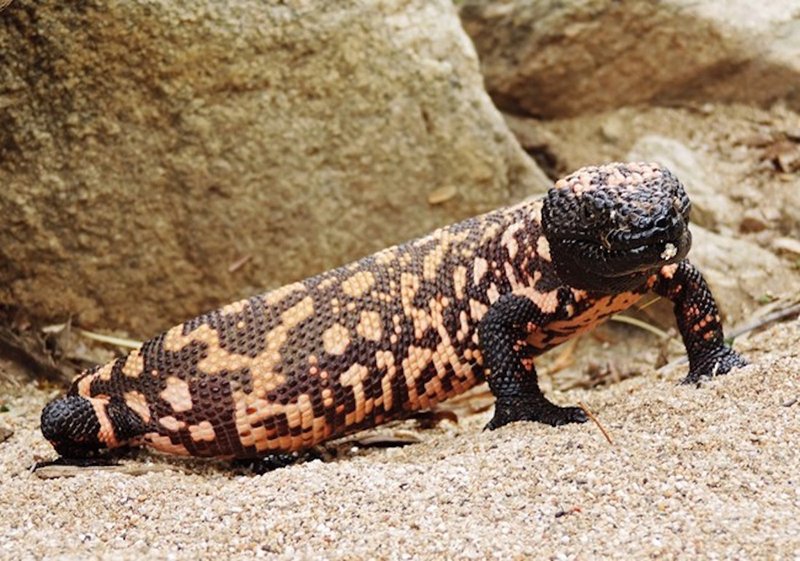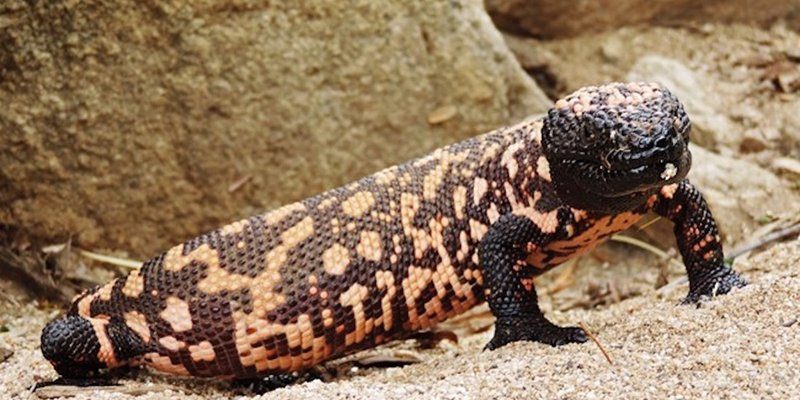
The Gila monster is one of only a few venomous lizards in the world. You might be wondering, “Can this slow-moving creature really pose a threat to humans?” Well, let’s dive into the world of the Gila monster and explore its habits, the real dangers it may present, and how to interact safely with this remarkable reptile.
Understanding the Gila Monster
The Gila monster (Heloderma suspectum) is a large lizard native to the deserts of Arizona, New Mexico, and parts of Mexico. It can grow up to 24 inches long and weighs around 3 to 5 pounds. Picture a creature that looks like a dragon’s baby, with a chunky body covered in bright orange and black scales. These colors serve as a warning to potential predators: “I’m not just any lizard; I’m a venomous one!”
Unlike many fast-running reptiles, Gila monsters are relatively slow. They typically move at a leisurely pace, which is part of their charm. They spend most of their time underground in burrows, coming out mainly to bask in the sun and hunt for food. Their diet consists mainly of small mammals, birds, and the eggs they can find. With their keen sense of smell, they can detect food even from a distance.
Not only are they unique in appearance, but Gila monsters also have a fascinating way of gaining nutrition. They store fat in their tails during times of food abundance, allowing them to survive during harsh conditions when food is scarce.
The Venom of the Gila Monster
Here’s where things get a little dicey. Gila monsters are one of only a few lizards that possess venom—a toxic substance used for self-defense and to immobilize prey. Their venom is delivered through grooves in their teeth when they bite down, making it quite effective. You might be thinking, “But how dangerous is this venom really?”
The venom of the Gila monster can cause significant pain, swelling, and sometimes lingering effects. It’s not life-threatening for most healthy adults, but it can be particularly harmful to children and those with compromised immune systems. Imagine being bitten by a creature that doesn’t let go easily! A Gila monster’s bite can last for hours, and the pain can be quite intense.
Still, it’s important to note that these lizards are generally not aggressive. They’re more likely to retreat than attack. Most incidents with Gila monsters occur when people accidentally step on or provoke them, often during hikes or while exploring their habitats.
How Often Do Gila Monster Bites Happen?
The good news is that Gila monster bites are relatively rare. Most people don’t come into contact with these creatures in the wild. According to wildlife experts, there are only a handful of reported bites each year. So while the Gila monster has the capacity to harm, most encounters don’t result in an injury.
In fact, many people live near Gila monsters without even knowing it! These lizards prefer to keep to themselves and would rather avoid confrontation. However, if you do encounter one, it’s crucial to give it space and not provoke it.
If you’re out in the wild and happen to spot a Gila monster, admire its beauty from a distance. Remember: they’re more scared of you than you are of them.
What to Do If Bitten by a Gila Monster
If you find yourself on the unfortunate end of a Gila monster bite, here’s what to do.
1. Stay Calm: It might sound easier said than done, but panicking can make the situation worse.
2. Seek Medical Attention: Get to a healthcare professional as soon as possible. While the venom isn’t usually life-threatening, you’ll want an expert to evaluate the injury.
3. Don’t Try to Remove It: Gila monsters have a strong grip and may not release their bite easily. Instead, wait for help.
The key here is quick action and not to take chances. While these bites are uncommon, the pain is significant, and medical attention is the best route.
Are Gila Monsters Protected Species?
Yes, they are! Gila monsters are considered a threatened species due to habitat loss and illegal collection. So, if you ever come across one, it’s important to respect its space and the laws protecting it.
Many regions have strict laws against capturing or harming Gila monsters. This makes it crucial for people to appreciate these unique creatures in their natural habitats rather than trying to keep them as pets. Respecting wildlife goes a long way in preserving our planet’s biodiversity!
How to Safely Observe Gila Monsters
If you’re interested in seeing a Gila monster up close, there are safe ways to do so. Here are a few tips:
- Go with a Guide: Join a guided nature tour in their natural habitat, where experts can help you understand how to observe them safely.
- Use Binoculars: If you spot one from a distance, watching with binoculars is a great way to enjoy the view without disturbing them.
- Stay on Trails: If you’re hiking in areas known for Gila monsters, stick to designated paths to reduce your chances of accidental encounters.
You might also check local wildlife centers or zoos that offer educational programs about these fascinating animals.
So, can the Gila monster be dangerous to humans? The answer is a bit complicated. While they can inflict a painful bite if provoked, they are not aggressive and generally avoid human interaction. Most people will go their whole lives without an encounter with one of these unique lizards. By respecting their space and understanding their behavior, you can safely enjoy the beauty of the Gila monster in its natural environment.
Remember, these intriguing creatures play an essential role in their ecosystems. Let’s appreciate them from a distance, so they can thrive for generations to come!

